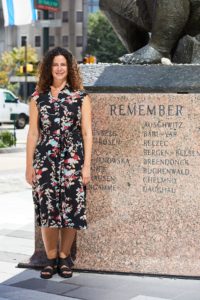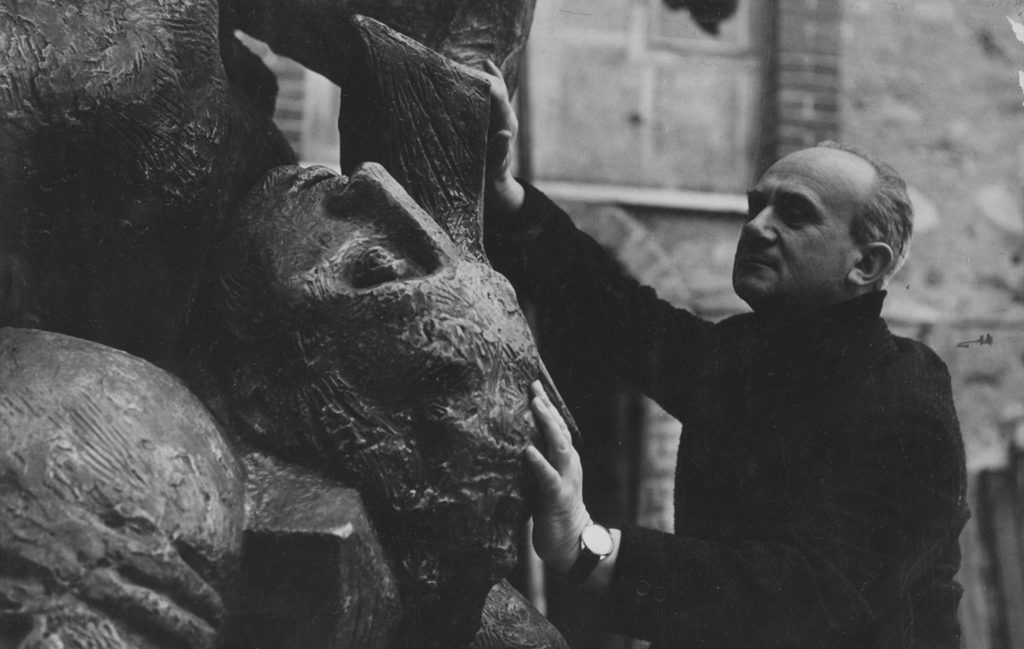Preserving the lessons of the past to build a future of tolerance
 July 23, 2021
Category: Featured, Long, Purpose
July 23, 2021
Category: Featured, Long, Purpose
Updates
Updated to remove outdated partnership information. (August 9, 2021 at 8:35 a.m.)On a foggy morning in Philadelphia, Eszter Kutas stands in the Horwitz-Wasserman Holocaust Memorial Plaza.
Located on 16th Street at the Benjamin Franklin Parkway, the site is home to America’s first public Holocaust monument, Nathan Rapoport’s powerful sculpture, “Monument to Six Million Jewish Martyrs,” and is now managed by the Philadelphia Holocaust Remembrance Foundation (PHRF).
Kutas became PHRF’s first executive director after serving as acting director for two years through Fairmount Ventures. At that time, as the project lead, she helped to oversee efforts to preserve the existing monument and reactivate the site for enhanced public access and education.
A native of Budapest, Hungary, Kutas is the granddaughter of four Holocaust survivors. Her commitment to the Holocaust Memorial project is both personal and professional; as staff attorney at The Claims Conference, Eszter oversaw the administration of a $1.25 Billion fund established by a consortium of Swiss Banks and supported the assessment of more than 80,000 Holocaust restitution claims across international borders.
“This work is incredibly personal to me,” said Kutas, “but one of the most valuable things our organization can teach people is that the lessons we can gain from studying the Holocaust are universal. People might think, ‘this was a long time ago’, or ‘this is not relevant to me because it is not my personal history.’ In fact, a nationwide study conducted last year found that 63% of those surveyed did not know that six million Jews were murdered during the Holocaust, and nearly half of those surveyed couldn’t name a single concentration camp or ghetto.”
“Unfortunately, when people are unable to see and connect with how history relates to them personally,” she said, “that history can be forgotten, and its lessons for the future lost.”
Construction at the Memorial Plaza began in the winter of 2017 and was completed in October 2018. The site is open to the public 24 hours a day, 7 days a week, with no admissions costs. The Plaza features five main elements in addition to the Monument:
- The Six Pillars, which juxtaposes the horrors of the Holocaust with American constitutional protections and values.
- A tree descended from one nurtured by children at the camp-ghetto of Theresienstadt, which symbolizes the human spirit triumphing over adversity.
- A video of an eternal flame, a symbol of remembrance for the six million Jews killed during the Holocaust.
- A tree grove at the edge of the Plaza, which represents the woods that sheltered those who resisted or hid from the Nazis in forests throughout Nazi-occupied Europe.
- Several original train tracks from the railroad which led to the Treblinka labor and death camp are embedded in the pavement in memory of the millions who were killed there.
Signs throughout the site explain each element, but visitors are also encouraged to download the IWalk app, available for both Android and iOS devices.
IWalk provides a virtual guided tour of the Memorial Plaza, connecting each feature of the Memorial Plaza with video testimony from Holocaust survivors and witnesses. Suitable for adults and children ages 10 and up, discussion questions in IWalk aim to jumpstart conversations about the importance of remembrance and the necessity of acting against bigotry and antisemitism.
IWalk is available for three audience groups — middle school, high school, and the general public. Participants can choose between three tour types: a 60-minute tour describing all of the Memorial Plaza features, as well as two special interest tours; one focusing on contemporary anti-Semitism; and one exploring the relationship between propaganda and the rise of anti-Semitism in Nazi Europe. The tours are available in English and in Spanish.
Kutas pointed to text on one of the Six Pillars which told the history of a local man. “This pillar features a quote from Leon Bass,” she said. “He was an African-American Philadelphian who fought in a segregated army unit in WWII and took part in the liberation of the Buchenwald concentration camp. He went on to become a principal of Benjamin Franklin High School and a human rights activist.”
“His unique perspective as both a victim of oppression and a witness to oppression can speak to the universality of bigotry and intolerance,” Kutas said, “and perhaps help some of our young African-American students relate this history to their own experiences.”
“The IWalk app is great for this as well,” she added, “because it contains videos with first-hand accounts from Holocaust survivors. When you can put a face to something, it feels more real and immediate.”
To ensure that every student in the Greater Philadelphia region is equipped to learn about the Holocaust in and out of the classroom, PHRF offers free professional development sessions for educators.
During each two-hour session, teachers are given learning tools for interacting with the elements in the Plaza and lesson plans which explore the intersectionality of antisemitism and racism. Lesson plans include preparation for visits, content and critical questions, as well as reflection and independent research. Teacher trainings are free, and teachers from the School District of Philadelphia may be eligible for professional development credits.
“We are trying to encourage critical thinking,” said Kutas. “When students visit, one of the things we point out is the dangers of propaganda. Nazi propaganda is one major example of information being disseminated in the public to influence or control large groups of people. Other forms of propaganda include, but are not limited to, anti-Black propaganda in the U.S. during the Jim Crow era and other forms of racist propaganda we see today on different outlets and platforms. Tying the past and the present demonstrates how propaganda comes in different forms, and we why must learn how to recognize and consider it with a critical lens.”
According to the United Nations Educational, Scientific and Cultural Organization (UNESCO), education about the Holocaust “demonstrates the dangers of prejudice, discrimination, and dehumanization, be it the antisemitism that fueled the Holocaust or other forms of racism and intolerance. It deepens reflection about contemporary issues that affect societies around the world, such as the power of extremist ideologies, propaganda, the abuse of official power, and group-targeted hate and violence.”
In today’s polarized political climate, fostering this kind of reflection in order to build a more tolerant future is more important than ever.
Trending News











